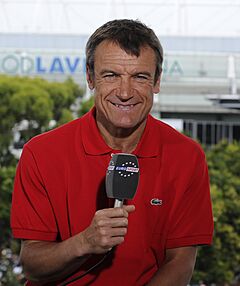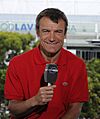Mats Wilander facts for kids

Wilander in the Eurosport studio during the 2014 Australian Open at Melbourne Park
|
|
| Country (sports) | |
|---|---|
| Residence | Hailey, Idaho, U.S. |
| Born | 22 August 1964 Växjö, Sweden |
| Height | 1.83 m (6 ft 0 in) |
| Turned pro | 1979 |
| Retired | 1996 |
| Plays | Right-handed (two-handed backhand) |
| Coach | John-Anders Sjögren |
| Prize money | US$7,976,256 |
| Int. Tennis HoF | 2002 (member page) |
| Singles | |
| Career record | 571–222 (72.01%) (72.0%) |
| Career titles | 33 |
| Highest ranking | No. 1 (12 September 1988) |
| Grand Slam singles results | |
| Australian Open | W (1983, 1984, 1988) |
| French Open | W (1982, 1985, 1988) |
| Wimbledon | QF (1987, 1988, 1989) |
| US Open | W (1988) |
| Other tournaments | |
| Tour Finals | F (1987) |
| WCT Finals | QF (1985, 1987, 1989) |
| Doubles | |
| Career record | 168–127 (56.9%) |
| Career titles | 7 |
| Highest ranking | No. 3 (21 October 1985) |
| Grand Slam doubles results | |
| Australian Open | F (1984) |
| French Open | SF (1985) |
| Wimbledon | W (1986) |
| US Open | F (1986) |
| Other doubles tournaments | |
| Tour Finals | F (1985) |
| Team competitions | |
| Davis Cup | W (1984, 1985, 1987) |
Mats Arne Olof Wilander (born August 22, 1964) is a famous Swedish former professional tennis player. He was once ranked as the world's number one player in men's singles. He held this top spot for 20 weeks, and was the year-end number one in 1988. Wilander won 33 singles titles and seven doubles titles during his career. This includes seven major tournaments, also known as Grand Slams. He won three French Open titles, three Australian Open titles, and one US Open title. He also won a major doubles title at Wimbledon.
Wilander became famous very quickly when he won the 1982 French Open at just 17 years old. He won his fourth major singles title by the age of 20, making him the youngest man to do so at that time. In 1988, he had an amazing year, winning three of the four Grand Slam singles titles. This helped him become the world's number one player. Wilander also won eight important tournaments called the Grand Prix Super Series. These were similar to today's ATP Masters 1000 tournaments. He was also a key player for the Swedish Davis Cup team, helping them reach seven finals and win three titles in the 1980s. Wilander is one of only seven men to have won major singles titles on all three main tennis court surfaces: grass courts, hard courts, and clay courts. He, along with Rafael Nadal and Novak Djokovic, are the only men to win at least two major singles titles on each of these three surfaces. Wilander stopped playing professionally in 1996.
In 1983, Wilander received the Jerring Award, a Swedish sports prize. In 2002, he was honored by being added to the International Tennis Hall of Fame.
Contents
Mats Wilander's Tennis Career
Early Years and Junior Success
Mats Wilander was born in Växjö, Sweden. He first caught the attention of the tennis world as a junior player. He won the French Open junior title, which is a big achievement for young players. He also won the European championships for players under 16 and under 18. In addition, he won the Orange Bowl under-16 event in Miami, Florida.
Becoming a Professional Player (1980–1988)
Wilander started his professional tennis career in 1980 at a clay court tournament in Båstad, Sweden. In September 1981, he played against his famous countryman, Björn Borg, for the only time in his career. Wilander lost that match in the first round of the 1981 Geneva Open.
Wilander surprised everyone at the 1982 French Open. He was an unseeded player, meaning he wasn't expected to win. But he beat several top players, including Ivan Lendl and José Luis Clerc. In the final, he defeated Guillermo Vilas in a long match that lasted almost five hours. This match was known for its very long rallies. At the end of his semifinal match, he showed incredible sportsmanship. He asked for a point to be replayed because he didn't want to win due to a questionable call by the referee. For this act of fair play, he received the Pierre de Coubertin World Fair Play Trophy. At 17 years and 9 months old, he became the youngest male Grand Slam singles champion ever at that time. He also won a Grand Slam title in only his third attempt, which was a record. Wilander finished 1982 ranked number 7 in the world. He also received the Svenska Dagbladet Gold Medal in Sweden.
In 1983, Wilander reached the final of the French Open again, but lost to Yannick Noah. Later that year, he won his second Grand Slam title at the Australian Open. This tournament was played on grass at Kooyong Stadium. He beat John McEnroe in the semifinal and Ivan Lendl in the final. He won eight other tournaments in 1983 and ended the year ranked number 4.
Wilander won the Australian Open again in 1984, defeating Kevin Curren in the final. He continued to play well in other tournaments and finished 1984 ranked number 4.
In 1985, Wilander won the French Open for the second time, beating Ivan Lendl in the final. He also reached the Australian Open final again, but lost to Stefan Edberg. He finished 1985 ranked number 3.
Wilander reached the number 2 ranking in April 1986, just behind Ivan Lendl. He teamed up with his countryman Joakim Nyström to win the men's doubles title at Wimbledon in 1986. He finished 1986 ranked number 3.
The year 1987 saw Wilander improve his serve and add a new, effective backhand shot. Despite these improvements, he lost to Ivan Lendl in the finals of both the French Open and the US Open. He finished 1987 ranked third in the world for the third year in a row.
The year 1988 was the best of Wilander's career. In January, he won his third Australian Open singles title. This time, the tournament was played on Melbourne Park's hardcourts. He beat Pat Cash in a tough five-set final. By doing this, he became the only player to win the Australian Open on both grass and hardcourt surfaces. He then won his third French Open title, beating Henri Leconte in the final. At the US Open, he reached his third Grand Slam final of the year. He defeated Ivan Lendl in another five-set match that lasted almost five hours. This victory ended Lendl's three-year reign as the world's top player. This was Wilander's seventh Grand Slam singles title. He became the number one ranked player in the world, having won three of the year's Grand Slam tournaments. He held the top ranking for 20 weeks.
His 1988 win at Cincinnati was his fourth title there. At the time, he was one of only three players since 1899 to win four titles in Cincinnati.
Later Career (1989–1996)
After his amazing 1988 season, Wilander's motivation and ranking dropped in 1989. He didn't win any tournaments that year and finished ranked number 12 in the world.
In 1990, Wilander briefly returned to the top 10 rankings. He reached the semifinals of the Australian Open, beating Boris Becker before losing to Stefan Edberg. He won the last singles title of his career in Itaparica.
Wilander played fewer tournaments in 1991 and was absent from the tour in 1992. He played a few tournaments in 1993 and 1994, but his ranking continued to drop.
In 1995, Wilander's results improved slightly. He reached the semifinals at the Canadian Open in Montreal, beating two top-ranked players before losing to Andre Agassi. He also reached the semifinals at New Haven.
In 1996, Wilander reached the final of a tournament in Pinehurst, North Carolina. This was his first ATP tournament final since 1990. He retired from professional tennis after playing his final match in Beijing in October.
During most of his career, Wilander used the Rossignol F-200 Carbon tennis racquet.
Davis Cup Achievements
Wilander was a very important part of Sweden's successful Davis Cup team throughout the 1980s. The Davis Cup is a major international team competition in men's tennis.
He helped Sweden reach their first final in 1983, where they lost to Australia. In 1984, Sweden, with Wilander, won the cup by beating the United States. Sweden won the cup again in 1985, defeating West Germany. Wilander helped Sweden reach the final again in 1986, but he did not play in the final because he was getting married. Sweden lost that year. Wilander played in his fourth final in 1987, where Sweden beat India. Sweden reached two more finals in 1988 and 1989, but lost both to West Germany. Wilander last played in the Davis Cup in the 1995 semifinals.
Wilander had a strong record in the Davis Cup, winning 36 singles matches and 7 doubles matches for Sweden. One of his most memorable Davis Cup matches was a loss in July 1982. In a quarterfinal match against the United States, he was defeated by John McEnroe in a very long match that lasted 6 hours and 32 minutes. This remains one of the longest singles matches in Davis Cup history.
Life After Professional Tennis
After retiring from playing professionally, Mats Wilander has continued to be involved in tennis. He sometimes plays on the senior tour, which is for older professional players. He has also served as the captain of the Swedish Davis Cup team. Wilander also works as a commentator for tennis matches on Eurosport, a sports television channel.
In 2007, Wilander started coaching tennis players. He coached Tatiana Golovin and later Paul-Henri Mathieu.
Personal Life
Mats Wilander earned a lot of money as a professional tennis player. He now spends much of his time living in Hailey, Idaho, United States. He lives there with his wife, Sonya (who was a model from South Africa). They started dating in 1985 and got married in 1987.
Wilander has four children: Emma, Karl, Erik, and Oskar. His son Erik has a mild form of epidermolysis bullosa, a skin condition. The cool, dry air in Idaho helps with his condition. Wilander and his wife have worked to raise money for research to find cures for this disease.
His brother, Anders Wilander, was the Mayor of Tranås Municipality in Sweden from 2006 to 2020.
In 2012, Wilander received the International Club's Jean Borotra Sportsmanship Award for his fair play and good conduct.
Images for kids
See also
 In Spanish: Mats Wilander para niños
In Spanish: Mats Wilander para niños
- Lendl–Wilander rivalry
- List of Grand Slam men's singles champions
- World number 1 ranked male tennis players


